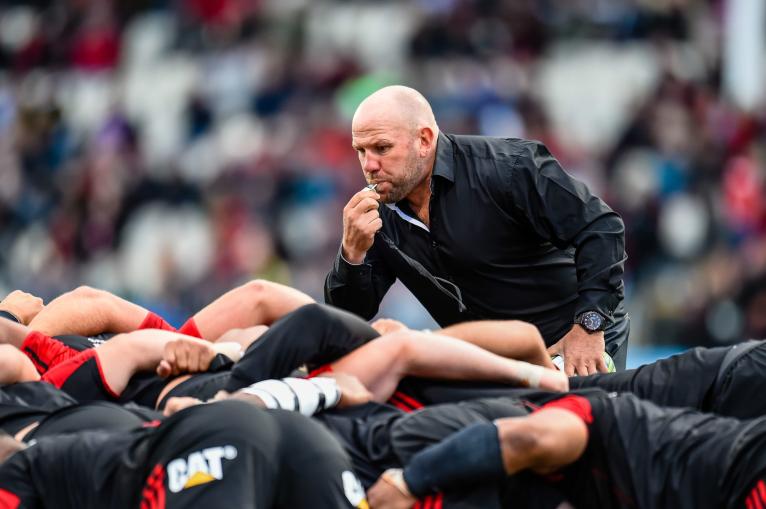The set scrum has been one of the great blights on the professional game. There are now far fewer scrums than there were back in the amateur era, but getting quick, clean ball from the set-piece has been an ever-increasing problem. Teams have been content to bend the myriad of technical rules to their advantage, win a penalty, and start from their attack from a lineout further upfield instead.
The stats culled from World Rugby’s summary of World Cups played support this view. World Cups played when the game was still amateur (between 1987 and 1995) averaged 28 scrums per game with 25 of those completed. Only 10.3 per cent ended in a penalty.
In the professional era (1999-2019) that all changed, with an average of only 10 scrums out of 15 completed and the penalty rate rising to 29.3 per cent. To put that all into perspective: there were twice as many scrums set at ‘amateur’ World Cups compared to the ‘professional’ version but the professional scrums resulted in three times the number of penalties awarded, and only 10 cases of usable ball – compared to 25 in the amateur era.
One of the scrum nadirs occurred in the 2021 series between the British and Irish Lions and South Africa, where only one-third of the scrums were completed and the set-piece yielded an average of just 4.5 usable balls per game for each side.
It was even worse in the decisive third Test, with the series square at one-all. Six of the 12 scrums finished in penalties, and the paltry 26 minutes of overall ball-in-play time was engulfed by the 12 minutes and 25 seconds it took to set up those scrums in the first place. Neutral observers could be forgiven for wondering whether it was worth the effort.

Although the penalty rate at scrum time in the latest iteration of Super Rugby Pacific is still relatively high, at just under 21 per cent after five rounds, there have been examples of good refereeing practice which have coincided with the resurgence of New Zealand scrummaging. That revival began to make itself felt with the appointment of ex-Crusaders forwards coach Jason Ryan to the All Blacks during the 2022 Rugby Championship.
By the second round of the tournament at Ellis Park, Ryan had the two huge young props that he wanted in situ: 6’4, 130-kilogram 27-year-old Tyrel Lomax at tighthead with the 6’3, 125-kilogram Ethan de Groot (three years younger) on the other side. Both men are Australian-born and Lomax started his Super Rugby career with the Melbourne Rebels.
The triangle of Lomax, De Groot and Ryan represented a fresh new start for the All Blacks scrum, after a July series against Ireland which had excluded all three of them. George Bower, Karl Tu’inukuafe and Aidan Ross had all been ranked above De Groot at loosehead for that series, while Ofa Tu’ungafasi, Angus Ta’avao and Nepo Laulala were ahead of Lomax in the pecking order on the tight-head.
Those omissions turned out to be an error of judgement, with Ireland looking more and more comfortable at scrum time as the series progressed. Head coach Ian Foster commented at the time on De Groot’s non-selection:
“With Ethan, we think he can get fitter, we think there is more to him, getting up off the ground and getting involved. We’ve got a really high regard for him and we’ll put a plan in place to give him an opportunity to come back.”
His consistent performances and selection for the All Blacks are testament to his dedication to improvement and the genuine talent he possesses.
Clarke Dermody on Ethan de Groot
Ethan de Groot confirmed that his work at the set-piece had not been in question, “just my work rate.” But Jason Ryan saw that the building blocks at the set-piece were in place, and he has never wavered from the De Groot-Lomax combination as his first choice at prop. When it really mattered, that pair started, and for the most part dominated in the second half of 2022.
Both have recently had their contracts with New Zealand Rugby extended until 2026. The stars of both young men are rising in parallel, and the words of Highlanders’ coach Clarke Dermody apply equally well to Tyrel Lomax, even if they were intended for Ethan de Groot:
“His consistent performances and selection for the All Blacks are testament to his dedication to improvement and the genuine talent he possesses. He has the capability over the next three years to play a lot of rugby for the All Blacks and to be a key part of the Highlanders [Hurricanes] engine room.”
Sentiments like that made the head-to-head meeting between the two in round seven of Super Rugby Pacific one for the connoisseurs of a good scrum battle. Going into the game at the Forsyth Barr Stadium, the Highlanders (+8 in scrum penalties) and Hurricanes (+6) owned the two best scrums in the competition statistically.
In the wider scheme of things, the match offered an excellent example of positive scrum management by Australian referee Damon Murphy, who purged the scrum trickster-ism early. Only three scrums out of 20 set ended in a penalty and none of them occurred after the first half hour of the game.

The majority of scrum penalties (70 per cent in SRP 2023) are won by the teams feeding the ball. They look to rotate up on one side of the scrum – typically on the loosehead side – and draw a technical offence out of the opponent. Law 19.19 gives the match official an easy way out: “Players may push provided they do so straight and parallel to the ground.”
Damon Murphy set out his stall at scrum-time, and put a stop to the shenanigans right from the start:
Murphy began by refusing to award Ethan de Groot penalties for walking around the corner and simulating scrum supremacy – what the telly commentary rightly called ‘the optics of dominance’.
In the first example, De Groot slides his head outside Lomax while his partner on the other side (Jermaine Ainsley) drops straight into the middle of the tunnel:

The appearance of de Groot’s head outside Lomax’s right shoulder, and his advanced position ahead of Ainsley are the tell-tale factors. There is only one team causing the scrum to slew and collapse, and it is not the Hurricanes.
In the second instance, Ainsley stays up, but De Groot is still shifting his feet left and pushing his head up and outside Lomax’s right armpit, forcing the scrum to break up. There is no intention to play the ball and Murphy correctly called a reset.
Ethan de Groot had to wait until the half-hour mark to receive his one and only penalty reward:
De Groot keeps his head in and Ainsley moves forward slightly before the scrum wheels, so there is much more reason to award a penalty to the Highlanders in this example than in the other cases.
Scrum penalties are largely determined by the team putting the ball in. The feeding side controls the ball, the duration of the scrum and therefore, the ability to squeeze technical penalties out of the opposition. When the Hurricanes finally began to receive a share of scrum feed towards the end of the first period, they looked completely stable. On one occasion, they looked a whole lot more than that:
In this instance Tyrel Lomax wins the initial battle of inches, pushing past De Groot’s left shoulder and splitting him away from hooker Andrew Makalio. The outcome has to be either a pushover try or a penalty try for collapsing if Ardie Savea does not lose control of the ball at the base.
The contest between Ethan de Groot and Tyrel Lomax was made all the more compelling by Damon Murphy’s refusal to take the easy way out in his officiating of the set-piece. His main criterion was to produce quality ball from completed scrums, and he succeeded, because none of the ten scrums in the second half ended in a penalty.
They produced clean breaks and tries instead:
Lomax and De Groot are still heaving and sweating in their mighty battle on the left of the Highlanders’ scrum, but the ball is being used constructively on attack, with number 8 Hugh Renton able to exploit the clean ball at the base generated by the new law-trial, which requires the defending scrumhalf to move back rather than forward beyond the mid-point of the set-piece after the ball is hooked.
The Hurricanes were also happy to use the extra space afforded by a stable platform to launch back-line assaults of their own:
The ball is shifted quickly away from the base, fullback Josh Moorby makes the extra man and Billy Proctor busts the line after a couple of simple passes out to the right.
The match between the Highlanders and the Hurricanes in Dunedin highlighted the huge potential upside of the scrum in the professional era. It featured two of the biggest and strongest young props in all of Super Rugby in the shape of Ethan de Groot and Tyrel Lomax, locking horns and struggling for supremacy with every fibre of their considerable beings.
It also featured a notable performance by referee Damon Murphy in the area of scrum management. Murphy showed that is quite possible to change behaviours, reduce the number of scrums played out purely for a penalty win, and restore the scrum to its rightful place as a unique platform for attacking rugby. In equal measure, that is a significant development for rugby in New Zealand, the Southern Hemisphere and for the global game as a whole.


Great read Nick. Very illuminating on the mysterious scrum for a long-retired back. Makes me want to go and drop $50 on NZ to win the RWC.
nice piece nick. much more enjoyable to see real scrum battles and set piece off the back of them. It still to this day shocks me to hear of 6' plus props. It used to be the position for the shorter folk such as myself! Maybe no longer the game for all shapes and sizes. I cannot in good conscience be a nine!
Had been waiting for weeks for the AB props contest and it did not disappoint.
Going to be handy with Samisoni between them for the next few years as they have all signed extended AB contracts.
Great stuff Nick.
Who knew that Lomax had the potential to be a world class tighthead? If it really was Ryan, what's Feek been doing? Remember how well we went when Cron stood in for him against Ireland too.
As a Chiefs fan I was relieved that our scrum just about did its job against the Canes on Saturday. We're not the same without Ta'avao.
You simply have to try these things and being a Skippy Referee the type who as a rule are very easily sucked in, that Ref' did good!
Looking forward to their development 😀